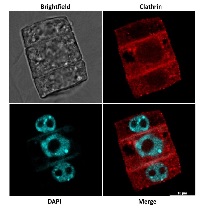1

Anti-Clathrin heavy-chain 1,2, DyLight® 594 conjugated (40 µg)
- Product Info
-
Immunogen: KLH-conjugated peptide derived from available plant clathrin heavy chain sequences including Arabidopsis thaliana clathrin heavy chain 1 UniProt: Q0WNJ6, TAIR:At3g11130, clathrin heavy chain 2 UniProt: Q0WLB5,TAIR:At3g08530 Host: Rabbit Clonality: Polyclonal Purity: Immunogen affinity purified serum, in PBS pH 7.4, conjugated to DyLight® 594.
Format: Liquid in PBS pH 7,4. Quantity: 40 µg Storage: Store at 4°C for 12-18 months, A preservative may be added for long time storage up to 2 years. Spin briefly the tube before use. Tested applications: Immunofluorescence (IF), Western blot (WB) Recommended dilution: To be determined by end user. Expected | apparent MW: 193 | 170 kDa (Arabidopsis thaliana) - Reactivity
-
Confirmed reactivity: Zea mays Predicted reactivity: Amborella trichopoda, Arabidopsis thaliana, Brassica napus, Capsella rubella, Chlamydomonas reinhardtii, Citrus aurantium var. sinensis, Eucalyptus grandis, Glycine max, Chlorella variabilis, Leucaena glauca, Lotus japonicus, Medicago tribuloides, Mimulus guttatus, Musa malaccensis, Nicotiana tabacum, Oryza sativa, Panicum italicum, Physcomitrium patens, Phaseolus vulgaris, Pisum sativum, Populus balsamifera, Populus trichocarpa, Ricinus communis, Selaginella moellendorffii, Sisymbrium salsugineum, Solanum lycopersicum, Theobroma cacao, Triticum aestivum, Vitis vinifera, Zea mays.
Species of your interest not listed? Contact usNot reactive in: Nicotiana benthamiana - Application Examples
-

Material: Zea mays hybrid variety
Preparation
5 days-old germinating maize root tips were cut and fixed with 4% formaldehyde, 60 min, RT. Cell walls were digested with enzymes cellulase and pectinase in MESbuffer for 90 min, RT. After washing with PBS, roots were squashed gently using a flat tip forceps to release the cells into PBS buffer. Cells were allowed to settle O/N at 4°C, followed by immunolocalization.
Immunocytochemistry (ICC)
Cells were permeabilized with 0.5% Triton X-100, 10 min, RT, followed by washing with PBS buffer before blocking with 5% fish gelatin-PBS, 30 min, RT.
Detection antibody: Cells were incubated with rabbit anti-clathrin 1,2 primary antibodies conjugated with DyLight®594 (AS10 690-DL594, Agrisera) for 3h/RT in the dark at 1:100 dilution. Nuclei were stained with DAPI followed Fluoromount-G mounting (Southern Biotech).
Courtesy of Dr. Ferhan Ayaydin and Dr. Divya Teja Dondapati, Hungarian Centre of Excellence for Molecular Medicine, (HCEMM), Szeged, Hungary. - Additional Information
-
Additional information: DyLight® 594 has Amax = 593 nm, Emax = 618 nm. DyLight® is a registered trademark of Thermofisher Inc., and its subsidiaries.
- Background
-
Background: Clathrin is a protein involved in intracellular trafficking and plays a major role in the formation of coated vesicles, It consists of three clathrin heavy chains and three light chains, Clathrin-coated vesicles (CCV) selectively sort cargo at the cell membrane, trans-Golgi network, and endosomal compartments for multiple membrane traffic pathways. - Protocols
-
Agrisera Western Blot protocol and video tutorials
Protocols to work with plant and algal protein extracts
Agrisera Educational Posters Collection
- Reviews:
-
This product doesn't have any reviews.
Accessories

AS13 2640 | Clonality: Polyclonal | Host: Rabbit | Reactivity: Agostis stoloniferacv. ‘Penncross’,Arabidopsis thaliana, Brassica sp., Cannabis sativa L., Cucumis sativus, Cynara cardunculus, Glycine max, Hordeum vulgare, Nicotiana tabacum, Phaseolus vulgaris, Phoenix dactylifera, Picrorhiza kurroa, Setaria italica, Solanum tuberosum, Triticum aestivum, Zea mays

AS10 690-HRP | Clonality: Polyclonal | Host: Rabbit | Reactivity:Arabidopis thaliana, Chlamydomonas reinhardtii, Nicotiana tabacum

AS08 327 | Clonality: Polyclonal | Host: Rabbit | Reactivity: Arabidopsis thaliana, Zea mays | Cellular [compartment marker] of Golgi in immunolocalization and of COP1 in western blot

